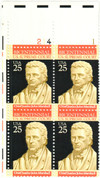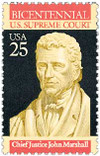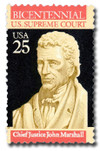
# 2415 - 1990 25c Constitution Bicentennial: US Supreme Court
U.S. #2415
1990 25¢ US Supreme Court
Constitution Bicentennial
- Issued on the 200th anniversary of the Supreme Court’s first session
- Final stamp in Government Branches mini-series
- Pictures John Marshall, America’s longest-serving Supreme Court Justice
Stamp Category: Commemorative
Series: Constitution Bicentennial
Value: 25¢, first-class rate
First Day of Issue: February 2, 1990
First Day City: Washington, DC
Quantity Issued: 150,545,000
Printed by: Bureau of Engraving and Printing
Printing Method: Lithographed and Engraved
Format: Panes of 50 in sheets of 200
Perforations: 11
Why the stamp was issued: As part of a series commemorating the 200th anniversary of the US Constitution. This was also the final stamp in a mini-series honoring the three branches of our government. It was issued on the 200th anniversary of the Supreme Court’s first session, February 2, 1790, in what was then the US capital, New York City.
About the stamp design: Selecting a fitting image for the Supreme Court stamp turned out be more difficult than any of the other stamps in the series. Artist Howard Koslow mocked up several stamps depicting figures from a plaster relief in the original Supreme Court chamber. He also submitted designs showing busts of early chief justices John Jay and John Marshall, at the suggestion of a sitting Supreme Court justice they’d shown the stamp designs to. Eventually, it was decided that the stamp would picture John Marshall. The likeness was based on multiple sources: a seated bronze statue by William Wetmore that sits in the Supreme Court building, an 1828 John B. Martin painting that hangs in the Supreme Court justices’ conference room, an engraving by Charles Schlecht, and a painting by Henry Inman.
First Day City: The First Day ceremony for this stamp was held in the Lower Great Hall of the Supreme Court building.
About the Constitution Bicentennial Series: This series was produced in 1989 and 1990 to commemorate the 200th anniversary the Constitution as well as our three branches of government it created. However, the USPS opted to do four stamps, so both chambers of Congress could have their own stamps. Both for political considerations and because they each have their own anniversary dates.
The three branches had previously been honored on stamps as part of a set honoring the 150th anniversary of the creation of the District of Columbia. That set pictured each of the buildings in which the operated. Early mockups for the Bicentennial stamps also included these buildings along with other recognizable symbols associated with the branches. The Citizens’ Stamp Advisory Committee felt that had been done enough times already and wanted to do something else. Eventually they settled on depictions of sculptural objects relating to each branch with a matching black and gold color scheme. Stamp artist Howard Koslow visited the US Capitol and Supreme Court and spoke to experts and historians about which subjects would be best for each stamp.
History the stamp represents: America’s longest-serving chief justice of the Supreme Court, John Marshall, was born on September 24, 1755, in Germantown, Virginia.
The eldest of fifteen children, Marshall only had one year of formal education as a child (during which time he befriended future president James Monroe). Despite this, his parents encouraged his love of reading, and he read widely to educate himself.
Following the Battles of Lexington and Concord in 1775, Marshall joined the Continental Army. He spent the winter of 1777-78 at Valley Forge with General George Washington’s forces. He was promoted to captain in 1778. Although he had little formal education, Marshall studied law at the College of William and Mary and was admitted to the Virginia bar in 1780. He quickly established a career defending individuals against their pre-Revolutionary War, British debtors.
Marshall served several terms of office in Virginia’s House of Delegates. As a delegate to the constitutional convention, Marshall spoke forcefully in favor of a new constitution to replace the weak Articles of Confederation. After declining several positions in the Washington and Adams administrations, Marshall served briefly in the US House of Representatives.
In 1797, President Adams appointed Marshall to a delegation to France. The diplomatic negotiations were halted when the representatives refused to pay a bribe to the French. This became known as the XYZ Affair. The delegation left in April 1798. The following year, Adams appointed Marshall to be his secretary of State. He took office in June 1800. In this position Marshall negotiated the end to the Quasi-War, which was the result of the XYZ Affair. The arrangement brought peace between the US and France.
Marshall was appointed chief justice of the Supreme Court in 1800. The Senate confirmed his appointment on January 27, 1801, and he was sworn in on January 31, officially taking office on February 4. Marshall continued to serve as secretary of State as well until Adams’s term was completed one month later.
Marshall understood that the Constitution was the supreme law of the land, as is stated in Article VI. As such, any law enacted by a branch of government must adhere to its principles or be struck down as unconstitutional. The Supreme Court’s landmark decision in Marbury vs. Madison, which determined that an action by a public official violated another’s constitutional rights, reflected this concept of judicial review. Judicial review, which is the practice of reviewing actions of government branches, firmly established the Supreme Court’s powers.
As chief justice of the US Supreme Court for 34 years, Marshall participated in more than 1,000 decisions and authored more than 500 opinions. The legacy of the Marshall Court was an increase in the power of the Supreme Court as a branch of the federal government. It placed an emphasis on the role of the judiciary.
As a close friend of George Washington, Marshall announced Washington’s death in 1799, offered the eulogy at his funeral, and led the commission that planned the Washington Monument. At the request of Washington’s family, Marshall wrote a five-volume biography about our nation’s first president, The Life of George Washington. John Marshall died in 1835, ending the longest tenure of any chief justice in Supreme Court history.
U.S. #2415
1990 25¢ US Supreme Court
Constitution Bicentennial
- Issued on the 200th anniversary of the Supreme Court’s first session
- Final stamp in Government Branches mini-series
- Pictures John Marshall, America’s longest-serving Supreme Court Justice
Stamp Category: Commemorative
Series: Constitution Bicentennial
Value: 25¢, first-class rate
First Day of Issue: February 2, 1990
First Day City: Washington, DC
Quantity Issued: 150,545,000
Printed by: Bureau of Engraving and Printing
Printing Method: Lithographed and Engraved
Format: Panes of 50 in sheets of 200
Perforations: 11
Why the stamp was issued: As part of a series commemorating the 200th anniversary of the US Constitution. This was also the final stamp in a mini-series honoring the three branches of our government. It was issued on the 200th anniversary of the Supreme Court’s first session, February 2, 1790, in what was then the US capital, New York City.
About the stamp design: Selecting a fitting image for the Supreme Court stamp turned out be more difficult than any of the other stamps in the series. Artist Howard Koslow mocked up several stamps depicting figures from a plaster relief in the original Supreme Court chamber. He also submitted designs showing busts of early chief justices John Jay and John Marshall, at the suggestion of a sitting Supreme Court justice they’d shown the stamp designs to. Eventually, it was decided that the stamp would picture John Marshall. The likeness was based on multiple sources: a seated bronze statue by William Wetmore that sits in the Supreme Court building, an 1828 John B. Martin painting that hangs in the Supreme Court justices’ conference room, an engraving by Charles Schlecht, and a painting by Henry Inman.
First Day City: The First Day ceremony for this stamp was held in the Lower Great Hall of the Supreme Court building.
About the Constitution Bicentennial Series: This series was produced in 1989 and 1990 to commemorate the 200th anniversary the Constitution as well as our three branches of government it created. However, the USPS opted to do four stamps, so both chambers of Congress could have their own stamps. Both for political considerations and because they each have their own anniversary dates.
The three branches had previously been honored on stamps as part of a set honoring the 150th anniversary of the creation of the District of Columbia. That set pictured each of the buildings in which the operated. Early mockups for the Bicentennial stamps also included these buildings along with other recognizable symbols associated with the branches. The Citizens’ Stamp Advisory Committee felt that had been done enough times already and wanted to do something else. Eventually they settled on depictions of sculptural objects relating to each branch with a matching black and gold color scheme. Stamp artist Howard Koslow visited the US Capitol and Supreme Court and spoke to experts and historians about which subjects would be best for each stamp.
History the stamp represents: America’s longest-serving chief justice of the Supreme Court, John Marshall, was born on September 24, 1755, in Germantown, Virginia.
The eldest of fifteen children, Marshall only had one year of formal education as a child (during which time he befriended future president James Monroe). Despite this, his parents encouraged his love of reading, and he read widely to educate himself.
Following the Battles of Lexington and Concord in 1775, Marshall joined the Continental Army. He spent the winter of 1777-78 at Valley Forge with General George Washington’s forces. He was promoted to captain in 1778. Although he had little formal education, Marshall studied law at the College of William and Mary and was admitted to the Virginia bar in 1780. He quickly established a career defending individuals against their pre-Revolutionary War, British debtors.
Marshall served several terms of office in Virginia’s House of Delegates. As a delegate to the constitutional convention, Marshall spoke forcefully in favor of a new constitution to replace the weak Articles of Confederation. After declining several positions in the Washington and Adams administrations, Marshall served briefly in the US House of Representatives.
In 1797, President Adams appointed Marshall to a delegation to France. The diplomatic negotiations were halted when the representatives refused to pay a bribe to the French. This became known as the XYZ Affair. The delegation left in April 1798. The following year, Adams appointed Marshall to be his secretary of State. He took office in June 1800. In this position Marshall negotiated the end to the Quasi-War, which was the result of the XYZ Affair. The arrangement brought peace between the US and France.
Marshall was appointed chief justice of the Supreme Court in 1800. The Senate confirmed his appointment on January 27, 1801, and he was sworn in on January 31, officially taking office on February 4. Marshall continued to serve as secretary of State as well until Adams’s term was completed one month later.
Marshall understood that the Constitution was the supreme law of the land, as is stated in Article VI. As such, any law enacted by a branch of government must adhere to its principles or be struck down as unconstitutional. The Supreme Court’s landmark decision in Marbury vs. Madison, which determined that an action by a public official violated another’s constitutional rights, reflected this concept of judicial review. Judicial review, which is the practice of reviewing actions of government branches, firmly established the Supreme Court’s powers.
As chief justice of the US Supreme Court for 34 years, Marshall participated in more than 1,000 decisions and authored more than 500 opinions. The legacy of the Marshall Court was an increase in the power of the Supreme Court as a branch of the federal government. It placed an emphasis on the role of the judiciary.
As a close friend of George Washington, Marshall announced Washington’s death in 1799, offered the eulogy at his funeral, and led the commission that planned the Washington Monument. At the request of Washington’s family, Marshall wrote a five-volume biography about our nation’s first president, The Life of George Washington. John Marshall died in 1835, ending the longest tenure of any chief justice in Supreme Court history.













